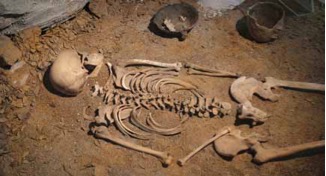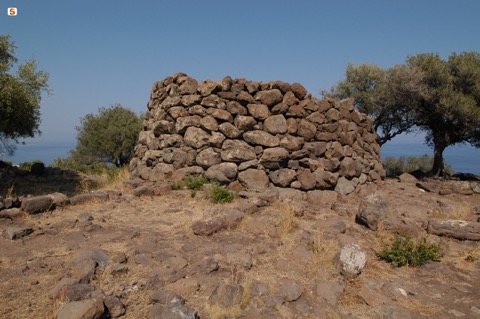Dorgali during the Nuraghic Age
The pottery found in the underground tombs (domus de janas of Mariughìa and Lottoniddo), caves and rock shelters (San Giovanni Su Anzu, Sisaia, Sas Furmicas, Fuili, Bue Marino), and in the megalithic funerary monuments (dolmen of Sa Barva) prove the inhabitation of the territory of Dorgali during the earliest phase of the Bronze Age (Bonnanaro Culture, 1800-1600 B.C.). In a narrow ravine of the Lanaittu valley between Oliena and Dorgali, speleologists discovered a nearly complete skeleton of an adult woman linked to modest grave goods which include a bowl, a pan and a granite millstone. It was renamed Sisaia, the ancestor. The extraordinary datum of this archaeological discovery was given by the cranial trepanation performed while she was alive, a widespread ritual practice for religious and therapeutic purposes throughout Sardinia and in Europe.

In the territory of Dorgali, characterised essentially by three large geomorphological areas (river valleys, the plateau of Dorgali and the rugged coast which had difficulties in communicating with the hinterland), a large number of monuments of Nuraghic Age (XVII- VI century B.C.) have been found: Nuraghe, walls, inhabited villages, wells and giants’ tombs. For the majority of these it is difficult to establish the period when they were built and their duration of use because of the insufficient and insignificant associated artefact discoveries on the surface.
So far 44 Nuraghe have been surveyed (fig. 2), located at the edge of the valleys and of the roads. The majority is now mostly reduced to ruins; single-tower or complex plan types were built using natural stone, which has from time to time conditioned their planimetric development.

As regards the settlement aspect, there are 111 known Nuraghic villages, detectable from the outcrops of walls and/or the findings of mobile material on the surface. The most densely populated centres are always located in relatively flat areas: examples are Dughine, Fruncudunue, Iriai I and II, Noriolo, Poddinosa and Ruju, and especially Serra Orrios (fig. 3).
They stood either within an area protected by the Nuraghe, within the defensive lines defined by the large forts with village, or, the majority, was autonomous and independent. These villages were made up of huts, whose numbers and complexity differed. The huts were modest stone houses with roofs made of branches and planks. The interior finish was often completed by mud which served as plaster and sometimes cork was used as insulation from the cold. The centre of the room was almost always occupied by the hearth while beds and tables for domestic work were ranged along the side walls. Sometimes there were also niches.

Documents within the funerary sphere indicate that there are over forty giants’ tombs (fig. 4); this highlights the large ratio of this type of monument in relation to the number of Nuraghe so far counted. These tombs are often located near the Nuraghe or the villages, with which they share a closely related topographic and cultural bond, or they are completely isolated, in pairs or in threes (Biristeddi). Built in local stone, already plundered during ancient times, they are for the most part completely destroyed. Most of them are of the dolmen-orthostatic type, and still have their large arched, either monolithic or bilithic stele.

Religious architecture (fig. 5) appears to be attested by 19 wells (Sorgolitta, Nastallai, Dugulana) and a spring (S'Ulumu). Other architectural forms related to religious life are the small megaron temples built near the village of Serra Orrios.

Bibliografia
- FADDA M. A., Il Museo Speleo-Archeologico di Nuoro, Sardegna Archeologica. Guide e itinerari, 17, Sassari 2006, pp. 34-35.
- MANUNZA M.R., Dorgali. Monumenti antichi, Oristano, 1995, pp. 21-102.
- MORAVETTI A., Serra Orrios e i monumenti archeologici di Dorgali, Sardegna Archeologica. Guide e itinerari, 26, Sassari 1998, pp. 75-78, figg. 9-21.
- MORAVETTI A. (a cura di), Carbonia-Fonni, in La Sardegna. I Tesori dell’Archeologia, La Biblioteca della Nuova Sardegna, vol. 3, Sassari 2011, pp. 71-75.
- PULACCHINI D., Serra Orrios e i monumenti archeologici di Dorgali, Sardegna Archeologica. Guide e itinerari, 27, Sassari 1998.

 VR
VR